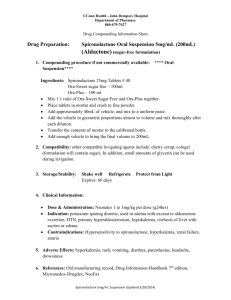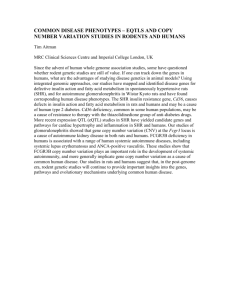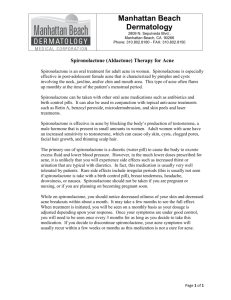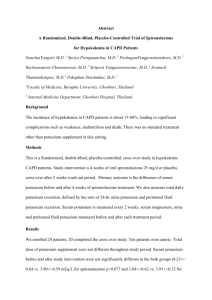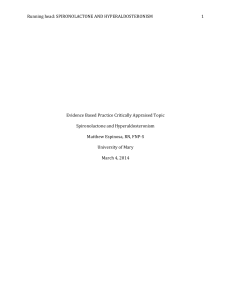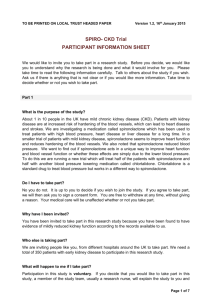volume-weighted mean glomerular volume in spontaneously
advertisement
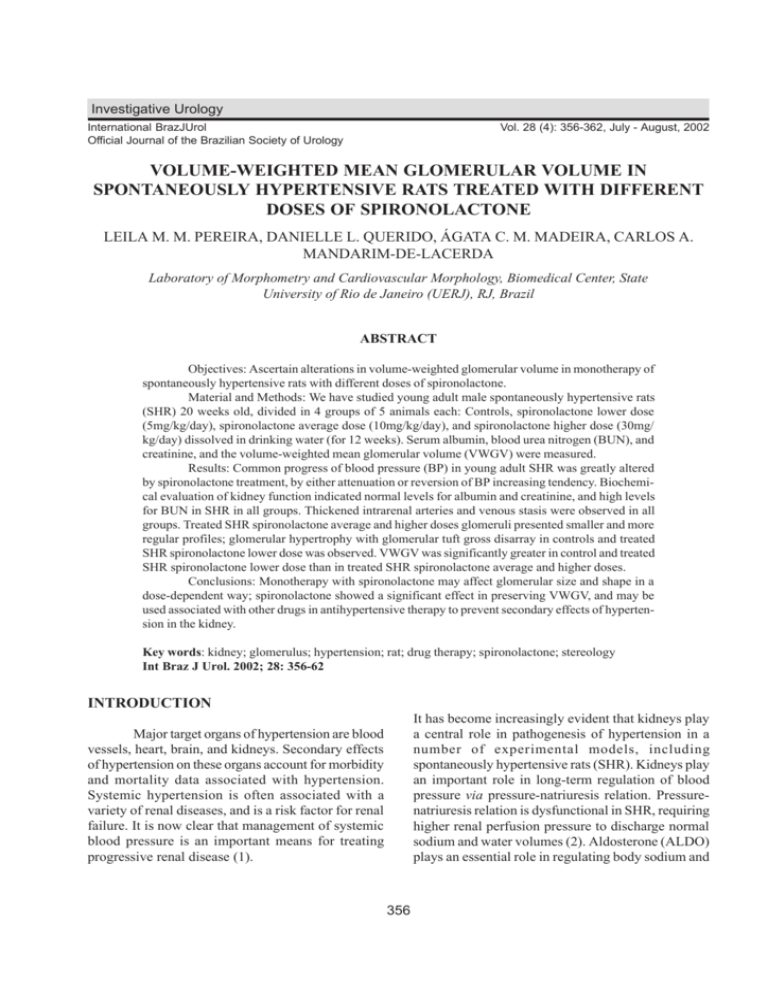
Investigative Urology International BrazJUrol Official Journal of the Brazilian Society of Urology Vol. 28 (4): 356-362, July - August, 2002 VOLUME-WEIGHTED MEAN GLOMERULAR VOLUME IN SPONTANEOUSLY HYPERTENSIVE RATS TREATED WITH DIFFERENT DOSES OF SPIRONOLACTONE LEILA M. M. PEREIRA, DANIELLE L. QUERIDO, ÁGATA C. M. MADEIRA, CARLOS A. MANDARIM-DE-LACERDA Laboratory of Morphometry and Cardiovascular Morphology, Biomedical Center, State University of Rio de Janeiro (UERJ), RJ, Brazil ABSTRACT Objectives: Ascertain alterations in volume-weighted glomerular volume in monotherapy of spontaneously hypertensive rats with different doses of spironolactone. Material and Methods: We have studied young adult male spontaneously hypertensive rats (SHR) 20 weeks old, divided in 4 groups of 5 animals each: Controls, spironolactone lower dose (5mg/kg/day), spironolactone average dose (10mg/kg/day), and spironolactone higher dose (30mg/ kg/day) dissolved in drinking water (for 12 weeks). Serum albumin, blood urea nitrogen (BUN), and creatinine, and the volume-weighted mean glomerular volume (VWGV) were measured. Results: Common progress of blood pressure (BP) in young adult SHR was greatly altered by spironolactone treatment, by either attenuation or reversion of BP increasing tendency. Biochemical evaluation of kidney function indicated normal levels for albumin and creatinine, and high levels for BUN in SHR in all groups. Thickened intrarenal arteries and venous stasis were observed in all groups. Treated SHR spironolactone average and higher doses glomeruli presented smaller and more regular profiles; glomerular hypertrophy with glomerular tuft gross disarray in controls and treated SHR spironolactone lower dose was observed. VWGV was significantly greater in control and treated SHR spironolactone lower dose than in treated SHR spironolactone average and higher doses. Conclusions: Monotherapy with spironolactone may affect glomerular size and shape in a dose-dependent way; spironolactone showed a significant effect in preserving VWGV, and may be used associated with other drugs in antihypertensive therapy to prevent secondary effects of hypertension in the kidney. Key words: kidney; glomerulus; hypertension; rat; drug therapy; spironolactone; stereology Int Braz J Urol. 2002; 28: 356-62 INTRODUCTION It has become increasingly evident that kidneys play a central role in pathogenesis of hypertension in a number of experimental models, including spontaneously hypertensive rats (SHR). Kidneys play an important role in long-term regulation of blood pressure via pressure-natriuresis relation. Pressurenatriuresis relation is dysfunctional in SHR, requiring higher renal perfusion pressure to discharge normal sodium and water volumes (2). Aldosterone (ALDO) plays an essential role in regulating body sodium and Major target organs of hypertension are blood vessels, heart, brain, and kidneys. Secondary effects of hypertension on these organs account for morbidity and mortality data associated with hypertension. Systemic hypertension is often associated with a variety of renal diseases, and is a risk factor for renal failure. It is now clear that management of systemic blood pressure is an important means for treating progressive renal disease (1). 356 MEAN GLOMERULAR VOLUME IN HYPERTENSIVE RATS potassium homeostasis by acting on epithelial tissues such as kidney and colon (3). In antihypertensive therapy, a revival of the effects of using spironolactone on blood pressure is due to the protective effect on heart, regarding left ventricular hypertrophy, and on kidneys, resulting in proteinuria reduction. Side effects are expected to be smaller when using individual drugs in monotherapy (spironolactone doses required for a truly effective antifibrotic regimen are not sufficient to satisfactorily decrease blood pressure in man in many cases, and is accompanied by the well-known side effects of ALDO antagonists as potentially serious hyperkalemia) (4). Organ protective effects of spironolactone may explain the prognostic value of anti-ALDO therapy in patients with severe chronic heart failure evaluated in Randomized Aldactone™ (spironolactone) Evaluation Study for Congestive Heart Failure (RALES) mortality trial (5). Glomerular morphology is altered in a variety of diseases states (6). Estimating renal glomerular volume is a useful technique with clinical, diagnostic, and prognostic relevance in several conditions, including renal artery stenosis (7), and glomerulosclerosis (8-11). The purpose of the present study is to determine alterations in the volumeweighted glomerular volume when treating SHR in monotherapy with different doses of spironolactone. Chemical Co., St. Louis, Lot 77H1291); c) Spironolactone, average dose group - SHR received spironolactone, 10mg/kg/day dissolved in drinking water; d) Spironolactone, higher dose group - SHR received spironolactone, 30mg/kg/day dissolved in drinking water. The Animal Experimentation Ethics Committee of the State University of Rio de Janeiro approved all protocols. Animal care according to the “Guide for the Care Use of Laboratory Animals” published by US National Institutes of Health (NIH) (Publication No. 85-23, revised 1996). Animals were individually lodged in the animal room, maintained at a temperature of 20-23°C, humidity of 55-65%, and 12-h light/dark cycle (artificial lights, 7–19h). SHR were fed a standard diet (Nuvilab™, Rio de Janeiro, Brazil) and had free access to fresh water. After the acclimatization period, animals were maintained alive and treated for 12 weeks. BP was weekly verified in conscious SHR using a noninvasive method of tail-cuff plethysmography (RTBP1007, Kent Scientific Co, Litchfield, CT, USA). At euthanasia (morning of day 91), animals were deeply anaesthetized, blood sample was collected directly from the heart, and then they were sacrificed (heart injection of 3 ml KCl at 10%). Serum albumin, BUN, and creatinine were measured (Central Laboratory of the University Hospital). MATERIALS AND METHODS Tissue Processing The left kidney was studied, divided into 2 halves and then placed 48h at room temperature in fixative (freshly prepared 4% w/v formaldehyde in 0.1M phosphate buffer pH 7.2), embedded in Paraplast Plus™ and sectioned using a systematic uniformly random sampled, sections were 3-µ m thick and stained with Masson trichrome and picro-sirius red. Young adult male SHR, 20 weeks old, weight 302 ± 28 g (mean ± standard deviation [SD]), were selected in this study. They have an initial systolic blood pressure (BP) of 151 ± 2 mmHg and were obtained from a colony maintained in our Laboratory of Morphometry & Cardiovascular Morphology (www2.uerj.br/~lmmc), Rio de Janeiro. They were separated into 4 groups of 5 animals each according to the following design: a) Control group – SHR manipulated and sacrificed as the animals of the experimental groups, but they only received water and food ad libitum; b) Spironolactone, lower dose group - SHR received spironolactone, 5mg/kg/day dissolved in drinking water (7a-(acetylthio)-17a-hydroxy-3oxopregn-4-ene-21-carboxylic acid g-lactone) (Sigma Stereology and statistical analysis Estimate of volume-weighted mean glomerular volume (VWGV) was made through the “point-sampled intercepts method” (12). Five microscopic fields were analyzed per section, 3 357 MEAN GLOMERULAR VOLUME IN HYPERTENSIVE RATS Table 1 – Descriptive statistics (mean ± SD) of volume-weighted glomerular volume (VWGV) and blood biochemistry in different groups of spontaneously hypertensive rats (SHR) treated with spironolactone (S). Significant differences among groups were tested with analysis of variance and multiple comparison test of Newman-Keuls. SHR groups VWGV (µm³.10 5) Albumin* (g/dl) Control (1) S lower dose (2) S average dose (3) S higher dose (4) 1 vs. 2 1 vs. 3 1 vs. 4 2 vs. 3 2 vs. 4 3 vs. 4 11.1 ± 1.7 8.8 ± 1.3 8.1 ± 1.3 7.8 ± 1.1 0.05 0.04 - 3.6 ± 0.3 3.8 ± 0.2 4.0 ± 0.4 3.4 ± 0.1 0.01 0.005 Urea** (mg/dl) 47.5 ± 4.7 46.0 ± 1.4 58.8 ± 6.0 65.8 ± 5.6 0.04 0.001 0.03 0.0008 - Creatinine*** (mg/dl) 0.5 ± 0.05 0.5 ± 0.07 0.6 ± 0.08 0.6 ± 0.05 0.04 0.05 - Reference values to Wistar rats (Sharp & La Regina, 1998). * 2.9 to 5.9g/dl; ** 11 to 23mg/dl; *** 0.4 to 1.4mg/dl sections per kidney, and 5 animals per group (75 fields per group). A test-system consisting of parallel lines associated with test points was superposed on each field. The direction of the lines on the sample was determined by lottery. For each point inside the unbiased counting frame, which hits a glomerulus intercept through the point, measurement of the intercept length was performed using a 32mm long logarithmic rule composed of a series of 15 classes, where width of any class is approximately 17% larger than that of the preceding class (13). Each individual intercept was cubed, and the mean of all values was multiplied by π/3 in every case to obtain VWGV (1415). Differences among groups were tested by analysis of variance, and multiple comparison Newman-Keuls test (16). this usual increasing of BP in young adult SHR was greatly altered by spironolactone treatment, with either attenuation or reversion of BP increasing tendency. SHR treated with spironolactone lower dose had a slight BP decrease (140 ± 1 mmHg in the last 2 weeks of experimentation). For SHR treated with spironolactone average and higher doses BP had an accentuated decrease, which was more evident after week 7 of experimentation. Biochemical evaluation of kidney function indicated normal levels for albumin and creatinine, and high levels for BUN in SHR in all groups. Serum albumin level was 11% higher in SHR treated with spironolactone average dose than in controls; this level was 15% lower in treated SHR higher dose than in SHR receiving spironolactone higher dose. BUN had no difference between control and spironolactone lower dose SHR. Creatinine and BUN were significantly more elevated in SHR treated with spironolactone average and higher doses. Renal cortical structure was quite similar in control and treated SHR spironolactone lower dose, and thickness of the interstitial collagen fibers surrounding the tubuli was slightly larger than that observed in SHR spironolactone average and higher dose groups. Thickened intrarenal arteries (mainly affecting the tunica media thickness) and venous stasis were observed in all groups. Glomerular size and RESULTS Results are summarized in Table-1 and Figures-1 and 2. Figure-1 shows BP variation in week 1, 7, and 12, for all groups. SHR had moderate hypertension at the beginning of the study, and no significant differences among the groups at this time. BP in control SHR increased after the first 4 weeks of experimentation, reaching the value of 177 ± 3 mmHg after 10 weeks, and then stabilized. However, 358 MEAN GLOMERULAR VOLUME IN HYPERTENSIVE RATS Figure 1 – Bar graph showing evolution of blood pressure in week 1, 7, and 12 of treatment with spironolactone (S). Asterisks indicate significant differences in a group (p < 0.05). The rat normal range for biochemical evaluation of kidney function is wide (17). BUN normally increases in high-protein diet or increased protein catabolism from gastrointestinal bleeding, corticosteroids, tissue trauma, burns, or tetracycline. It normally decreases in low-protein diet, or decreased protein catabolism from liver disease or cachexia. Like urea, creatinine is freely filtered at the glomerulus. Creatinine excretion is dependent on filtration. Increased serum creatinine occurs in increased creatinine or creatinine intake from a recent meal or the use of creatinine supplements for bodybuilding. Decreased serum creatinine occurs in decreased creatinine intake or generation from diminished muscle mass associated with cachexia, aging, or a low protein intake (18). BUN high levels found in all groups can be explained by the highprotein content of Nuvilab™ diet. Albumin and creatinine were both normal in all groups. Glomeruli had considerable and general alterations in rats submitted to a nitric oxide synthesis blockade (a model of systemic hypertension), characterized by global or segmental glomerular sclerosis. Renal parenchyma showed only some shape was the major microscopic difference among the groups. In treated SHR using spironolactone average and higher doses glomeruli had small and more regular profiles; in control and treated SHR spironolactone lower dose glomerular hypertrophy with glomerular tuft gross disarray was observed (Figure-2). The VWGV was significantly higher in control and treated SHR spironolactone lower dose than in treated SHR spironolactone average and higher doses. DISCUSSION The present report studied SHR since they were young adults treated with spironolactone monotherapy (varied doses). The study was extended for 12 weeks and BP, biochemical kidney functional tests, and VWGV were diversely affected by different treatments. Briefly, the effect of the spironolactone on the typical SHR BP increasing tendency and on VWGV was dose-dependent. This effect was modest on the BP using a spironolactone dose of 5mg/kg/ day, but it was pronounced using a dose of 30mg/kg/ day. 359 MEAN GLOMERULAR VOLUME IN HYPERTENSIVE RATS Figure 2 – Photomicrographs of SHR renal cortex after 12 weeks of treatment. Glomeruli are hypertrophied, have thick capsules, inner vascular disarray, and collagen fibers are slightly thickened in controls (A) and spironolactone lower dose (B) groups. Contrarily, in spironolactone average (C) and higher dose (D) groups, glomeruli are smaller and show less inner and capsular lesions. However, in all groups, intrarenal arteries are thickened (arrows) and many dilated intrarenal veins are observed (v). Calibration bar in A = 100 µm. Picro sirius red stain. 360 MEAN GLOMERULAR VOLUME IN HYPERTENSIVE RATS glomeruli presenting atrophic structure, tubular atrophy, and extensive fibrosis, and VWGV was 100% greater in these rats than in controls (11,15). Some previous studies considered monotherapy with spironolactone efficient to prevent or reduce cardiac fibrosis, even without simultaneous BP reduction. These studies used different spironolactone dose and via of administration, time of observations, as well as different experimental models or human individuals to support their conclusions. In equivalency to a 350g rat, spironolactone dose normally varied from 0.13 to 17.5mg/day (this study used 1.75 to 10.5mg/day), but Brilla (5) and Lacolley et al. (19) used an extreme dose of 200mg/kg/day (equivalent to 70mg/day in a 350g rat). Therefore, it yields confuse experimental group denominations, like “low dose” or “high dose” used in some studies. Antihypertensive therapy usually associates different drugs. Combination of spironolactone and ACE inhibitors must be administered only in the absence of hyperkalemia and significant renal dysfunction, and under careful monitoring of potassium levels and renal function (20). There is an advantage in the combination of spironolactone and blockade of calcium channels, because this drug can prevent organ fibrosis by attenuating the number of fribrogenetic potential of extracellular matrix producing myofibroblasts at sites of repair (21). This is possible because AngII and ALDO may synergistically operate on intracellular calcium, and an increased intracellular free calcium levels are associated with proliferation of fibroblasts (22). Finally, present results suggest that monotherapy with spironolactone may affect glomerular size and shape in a dose-dependent way; spironolactone showed a significant effect in preservation of VWGV and can be used associated with other drugs in antihypertensive therapy to prevent kidney secondary effects of hypertension. REFERENCES 1. 2. 3. 4. 5. 6. 7. 8. 9. 10. 11. 12. Supported by CNPq and FAPERJ grants. Luciene O. Sampaio and Thatiany S. Marinho provided technical assistance. 13. 361 Frohlich ED, Apstein C, Armstrong ML, Cohn JN, Cutler JA, Devereux RB, et al.: Target organ consequences in hypertension: pathogenesis and prevention. Hypertension. 1991; 18: I-143-I-145. Kost Jr CK, Li P, Willians S, Jackson EK: Renal vascular responses to angiotensin II in conscious spontaneously hypertensive and normotensive rats. J Cardiovasc Pharmacol.1998; 31: 854-61. Delcayre C, Silvestre JS: Aldosterone and the heart: towards a physiological function? Cardiovasc Res. 1999; 43:7-12. Maish B, Brilla C, Kruse T: Directions in antihypertensive treatment – our future from the past. Eur Heart J. 1995; 16 (Suppl C): 74-83. Brilla CG: Aldosterone and myocardial fibrosis in heart failure. Herz. 2000; 25: 299-306. Cahil MM, Kett MM, McCausland JE, Alcorn D, Bertram J: Glomerular stereology: Why, what and how to measure glomerular structure. Nephology. 1996; 2: 305-13. Marcussen N: Atubular glomeruli and the structural basis for chronic renal failure. Lab Invest. 1992; 66: 265-84. Fogo A, Hawkins EP, Berry PL, Glick AD, Ichikawa I: Glomerular hypertrophy in minimal change disease predicts subsequent progression to focal glomerular sclerosis. Kidney Int. 1990; 38: 115-23 . Irzyniec T, Mall G, Greber D, Ritz E: Beneficial effect of nifedipine and moxonidine on glomerulosclesrosis in spontaneously hypertensive rats- a micromorphometric study. Am J Hypertens. 1992; 5: 437-43. Perico N, Detcheva N, Khalil EL, Remuzzi G: Cyclosporine induces glomerulosclerosis:threedimensional definition of the lesions in rat model of renal transplant. Kidney Int. 1996; 49: 1283-88 . Pereira LMM, Mandarim-de-Lacerda CA: Glomerular profile numerical density per área and mean glomerular volume in rats submitted to nitric oxide synthese blockade. Histol Histopathol. 2001; 16: 15-20. Gundersen HJG, Jensen EB: Stereological estimation of the volume-weighted mean volume of arbitrary particles observed on random sections. J Microsc. 1985; 138: 127-42, . Sørensen FB: Stereological estimation of the mean and variance of nuclear volume from vertical section. J Microsc. 1989; 162: 203-29. MEAN GLOMERULAR VOLUME IN HYPERTENSIVE RATS 14. Mandarim-de-Lacerda CA: Estereologia e urologia: volume nuclear médio ponderado na classificação e prognóstico de tumores. Braz J Urol. 1999; 25: 286290 . 15. Mandarim-de-Lacerda CA, Pereira LMM: Renal cortical remodelling by NOs blockers in rats is prevented by ACE inhibitor and calcium channel blocker. J Cell Mol Med. 2001; 5: 276-83. 16. Zar JH: Biostatistical analysis. Upper Saddle River, Prentice-Hall,1999; p. 663. 17. Sharp PE, La Regina MC: The laboratory rat. Boca Raton, CRC Press, 1998; p. 214 . 18. Wilcox CS: Evaluation of Kidney Function: Biochemical and Nuclear Medicine Tests. In: Tischer CC, Wilcox CS (eds.). Nephrology & Hypertension. Philadelphia, Lippincott Williams & Wilkins,1999; pp.19-22 . 19. Lacolley P, Safar MR, Lucet B, Ledudal K, Labat C, Benetos A: Prevention of aortic and cardiac fibrosis by spironolactone in old normotensive rats. J Am Coll Cardiol. 2001; 37: 662-7. 20. Zannad F: Angiontensin-converting enzyme inhibitor and spironolactone combination therapy. New objectives in congestive heart failure treatment. Am J Cardiol. 1993; 71: 24A-39A . 21. Ramires FJA, Sun Y, Weber KT: Myocardial fibrosis associated with ALDO or angiotensin II administration: attenuation by calcium channel blockade. J Mol Cell Cardiol. 1998; 30: 475-83. 22. Sadoshima J, Izumo S: Molecular characterization of angiotensin II-induced hypertrophy of cardiac myocytes and hyperplasia of cardiac fibroblasts. Critical role of the AT1 receptor subtype. Cir Res. 1993, 73: 413-23. Received: January 8, 2002 Accepted after revision: February 15, 2002 Correspondence address: Dra. Leila Maria Meirelles Pereira Lab. de Morfometria & Morfologia Cardiovascular, UERJ Av. 28 de Setembro, 87 fundos Rio de Janeiro, RJ, 20551-030, Brazil Fax: + 55 21 2587-6416 E-mail: lmaria@uerj.br 362
